Introduction
Navigating the complexities of autism can be challenging for parents and caregivers, but understanding tools like the Autism Spectrum Quotient (AQ) can be an invaluable step. The AQ is a diagnostic measure designed to identify traits associated with autism, offering insights into various behavioral, social, and communication aspects. Accurate diagnosis is crucial, as it informs early intervention strategies that significantly enhance outcomes for children with autism.
This article delves into the intricacies of the AQ, its components, and how it functions, while also discussing the importance of professional assessments and the limitations of using the AQ as a standalone tool. By exploring these elements, the goal is to equip parents and caregivers with the knowledge and resources needed to support their children's development effectively.
Understanding the Autism Spectrum Quotient (AQ)
The Autism Spectrum Quotient (AQ) is a significant assessment instrument created to evaluate characteristics related to the condition. This tool comprises a series of questions that evaluate various aspects of behavior, social skills, and communication. Comprehending and applying the AQ can offer substantial insights into a person's behaviors concerning the spectrum of autism-related conditions, thus promoting awareness and informed conversations.
Diagnosing autism spectrum disorder (ASD) typically relies on parents' or caregivers' descriptions of their offspring's development and professional observations of the individual's behavior. The American Psychiatric Association's Diagnostic and Statistical Manual, Fifth Edition (DSM-5), offers standardized criteria to aid in diagnosing ASD. While there are numerous tools available to assess ASD in young individuals, no single tool should be solely relied upon for a diagnosis. Specialists such as neurodevelopmental pediatricians, child neurologists, and developmental-behavioral pediatricians often provide further assessments.
Historically, the definition of autism has evolved numerous times since its first description in 1943. Currently, the DSM-5 is the standard reference for diagnosing mental disorders, including ASD, in many countries like the United States. The diagnostic standards of this edition have been discussed, especially since observation-based assessments can be subjective. As a result, the National Institute of Mental Health (NIMH) promotes a transition towards assessments based on objective measurements, such as magnetic resonance imaging (MRI), which can provide noninvasive, high-level brain measurements.
The need for accurate and early diagnosis is critical. Research by the Autism Community in Action (TACA) emphasizes that early treatment, such as behavioral therapy, significantly improves outcomes for children. Current methods often deliver results too late or are ineffective, highlighting the urgent need for diagnostic tools capable of identifying ASD as early as possible. NeuroQure, for instance, is committed to providing timely and accurate diagnoses, potentially offering families support within weeks of birth and dramatically shortening the lengthy diagnostic process.
Involvement and assistance for youngsters with disabilities, including those on the spectrum, are essential for their mental well-being and fairness in society. Ensuring that caregivers have the necessary resources to support their children's development is crucial. Recognizing both the unmet needs and the strengths of autistic individuals can reduce chronic stress sources and promote a healthy family environment.
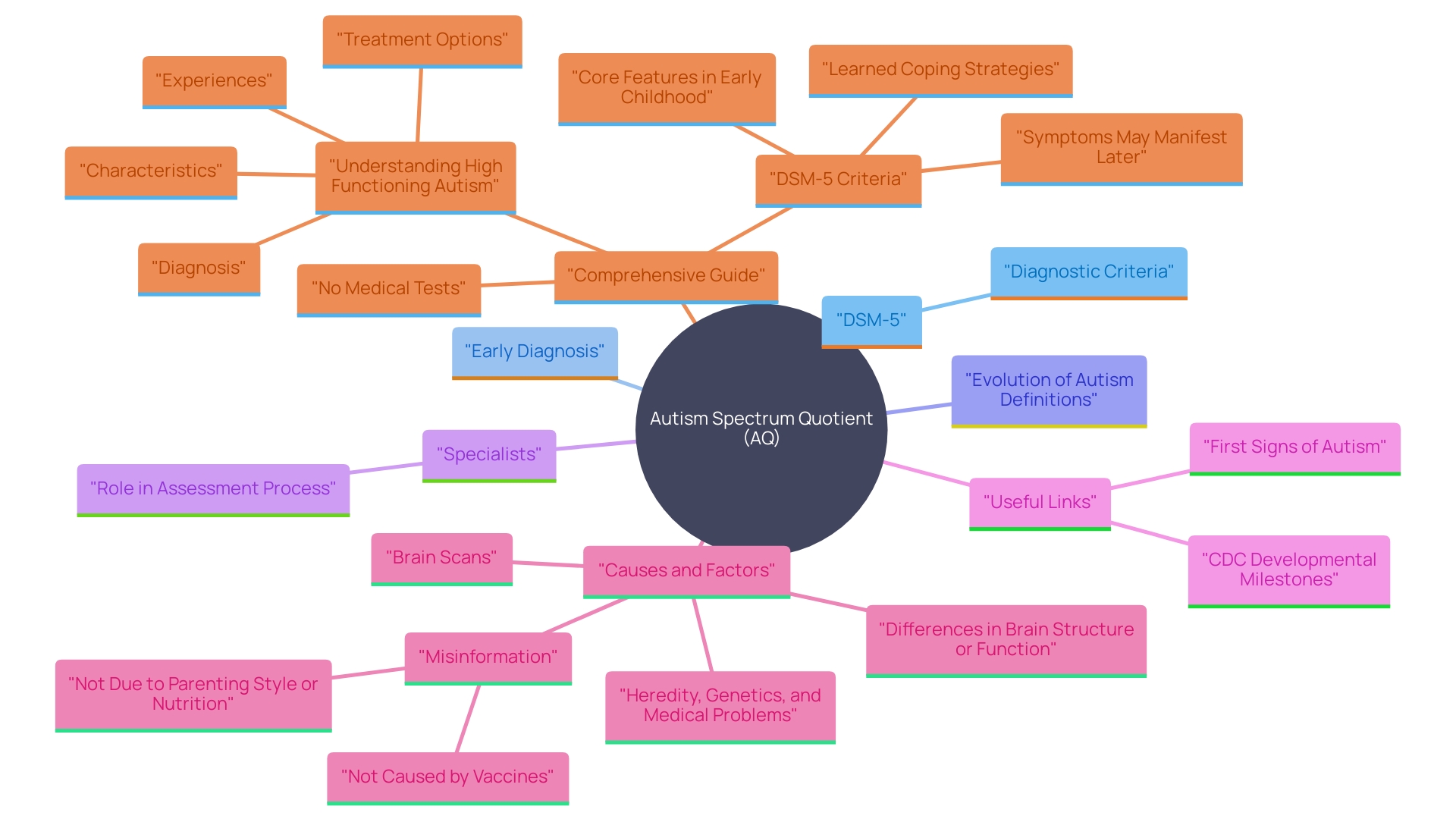
Components of the Autism Spectrum Quotient
The Autism Spectrum Quiz (AQ) features a series of questions that delve into various aspects such as social interaction, attention to detail, communication skills, and imagination. Each question is meticulously crafted to elicit responses indicative of traits commonly associated with developmental disorders. Understanding these components can provide valuable insights into interpreting the results and identifying areas where additional support might be beneficial. This approach aligns with research emphasizing the importance of early and accurate diagnosis for effective intervention. As indicated by The Autism Community in Action (TACA), early behavioral therapy significantly enhances results for children with the condition. Moreover, it's important to recognize that this condition is complex with no single cause, often linked to genetic factors and differences in brain structure. Getting to know these subtleties can assist in offering improved assistance and promoting a more inclusive atmosphere for individuals on the spectrum.
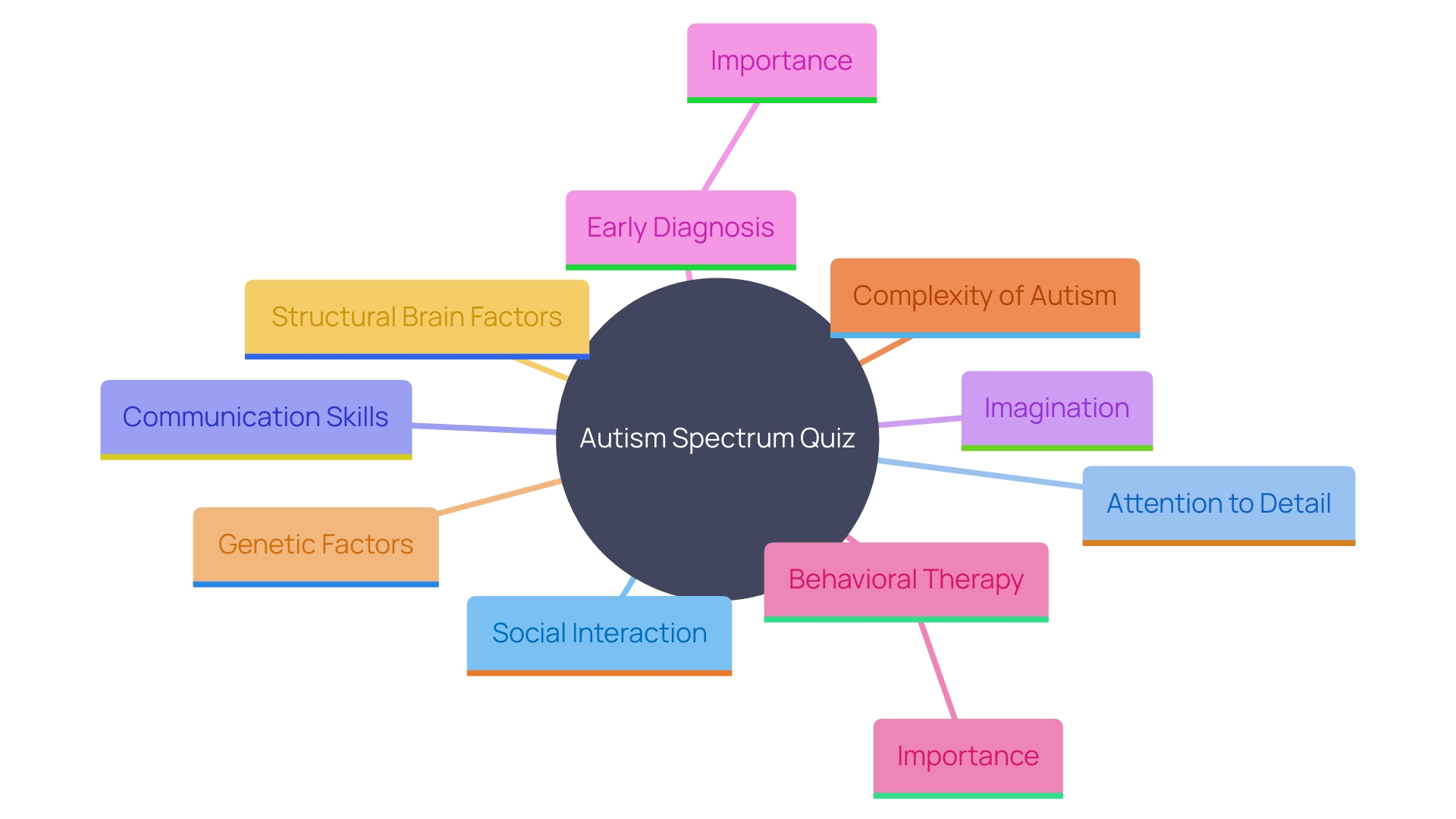
How the Autism Spectrum Quotient Works
The Autism Spectrum Quiz (AQ) utilizes a series of statements that respondents evaluate on a scale from 'definitely agree' to 'definitely disagree.' Each response is meticulously assessed, with the total score indicating the likelihood of characteristics associated with the condition. This methodical scoring system offers a structured way to comprehend behaviors, aiding parents and professionals in pinpointing potential concerns. Importantly, while the AQ is a valuable tool, it should not be the only foundation for a determination. According to the American Psychiatric Association’s DSM-5, diagnosing this condition typically involves both parental observations and professional evaluations of a child's behavior. These multi-faceted evaluations guarantee a more thorough understanding, aligning with modern initiatives to improve early and precise identifications.

Interpreting AQ Scores
Interpreting scores from the Autism Spectrum Quotient (AQ) requires a nuanced understanding of what different score ranges signify. Higher scores may suggest a greater presence of characteristics associated with the condition, whereas lower scores might indicate fewer traits. However, it's essential to acknowledge that the AQ is a screening instrument, not a conclusive assessment. Scores should be discussed with a qualified professional for accurate interpretation, ensuring the context of each individual's unique characteristics is considered.
The Autism Community in Action highlights the significance of a precise identification as the first step in addressing autism, advocating for early intervention to maximize positive outcomes. For instance, behavioral therapy initiated at an early age has shown significantly better results. This underscores the importance of timely and precise screening tools like the AQ.
Moreover, the terms and questions within the AQ can be interpreted differently across various stakeholders and professional disciplines, which can impact the results. Therefore, the involvement of professionals in interpreting these scores is vital to bridge any gaps in understanding and ensure that the results are used effectively.
'The importance of accurate and early identification is further emphasized by organizations like NeuroQure, which aim to shorten the assessment process from years to just a few weeks after birth.'. This rapid diagnosis is crucial in starting early interventions, which are proven to be more effective.
In summary, while the AQ can be a valuable tool in identifying potential traits related to the condition, its results should always be considered with professional guidance to ensure appropriate and effective follow-up actions.
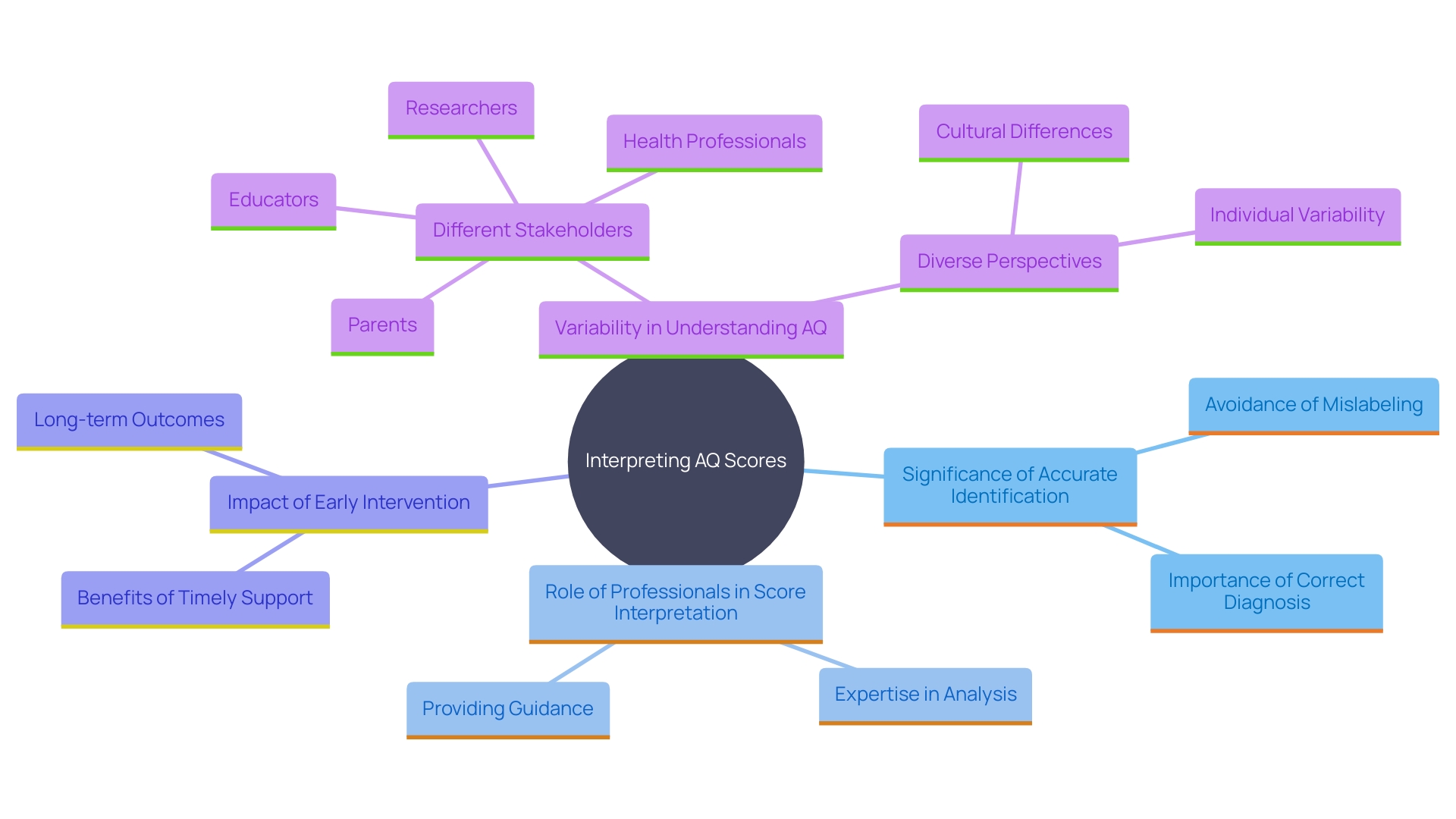
AQ Versions for Different Age Groups
The Autism Spectrum Quotient (AQ) offers various versions tailored to different age groups, ensuring the questions are age-appropriate and understandable. For example, the version for youngsters includes questions such as how often a young one raises their arms to request being carried or indicates what they find intriguing. These tailored questions help capture the nuances of communication and behavior in different age groups. The importance of choosing the correct version cannot be overstated, as it enhances the accuracy of the assessment and provides more meaningful insights. Precise early identification is essential, as studies consistently indicate that early intervention results in improved outcomes for children with autism. According to the Autism Community in Action (TACA), prompt and precise diagnosis is the initial stage in successful treatment, emphasizing the critical requirement for trustworthy resources such as the AQ.
Limitations and Use of AQ in Clinical Practice
While the Autism Spectrum Quiz (AQ) serves as a valuable resource, it is imperative to recognize its limitations. The AQ should never be utilized as a standalone diagnostic measure. Instead, it is best integrated into a comprehensive evaluation process that includes clinical assessments and direct observations. This approach is crucial, as it ensures a more holistic view of an individual's condition. As stated by the National Academies of Sciences, Engineering, and Medicine, the integration of different evaluation methods and expert insights is essential for developing effective policies and practices. Furthermore, the Interagency Autism Coordinating Committee (IACC) emphasizes the importance of coordinated efforts and diverse perspectives in research and services related to developmental disorders. 'Recognizing the limitations of resources like the AQ allows parents and professionals to navigate the assessment process more effectively, ensuring that interventions are based on a thorough understanding of each individual's unique needs.'.
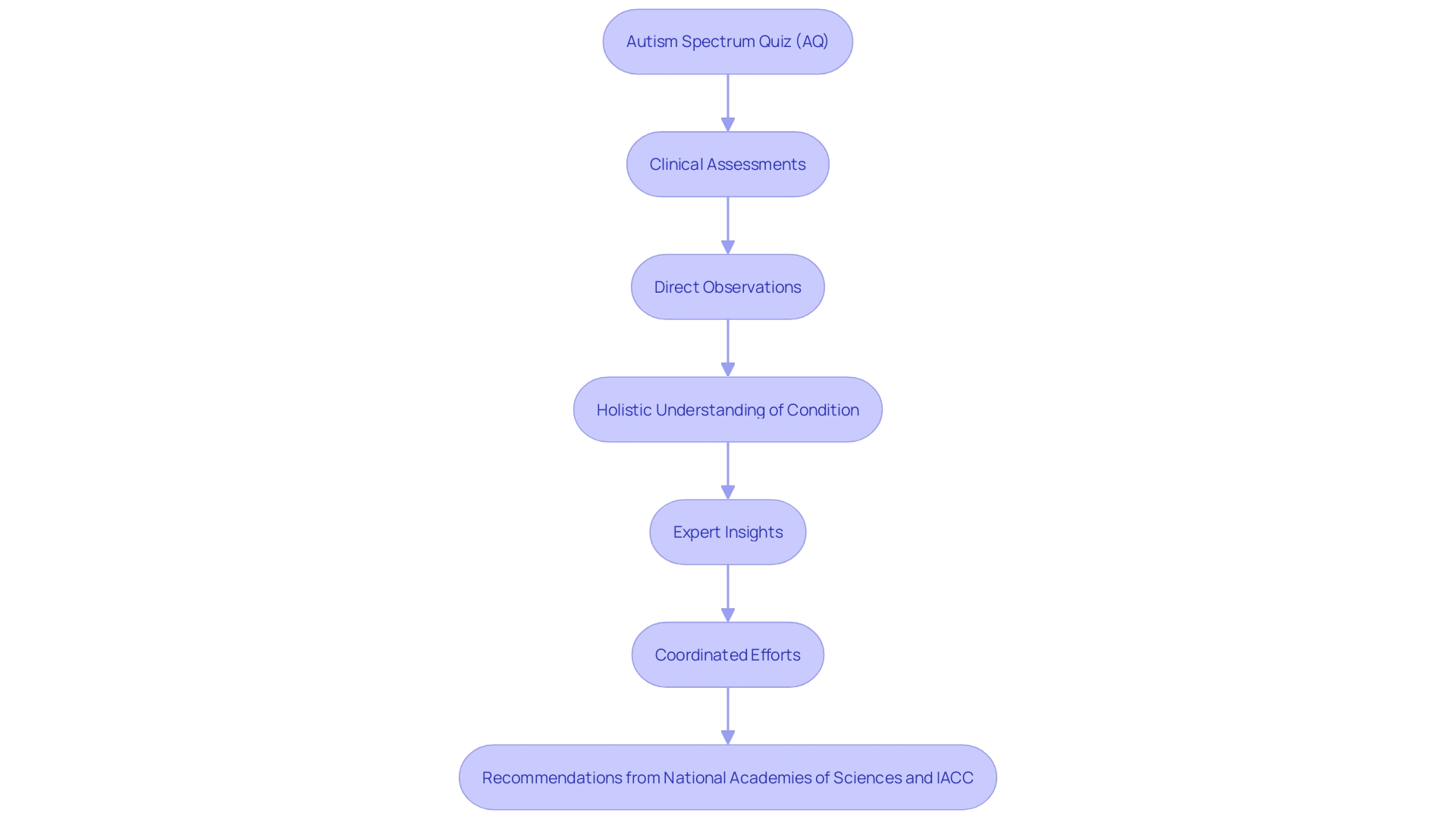
Other Screening Tools and Comparisons
Beyond the AQ, a variety of other assessment instruments are available to evaluate autism traits, each with its distinct focus and methodology. For instance, digital health products like mobile apps are emerging as valuable resources due to their scalability and ease of access. A notable example is the Canvas Dx app, which uses questionnaires and videos to provide diagnostic indications. Another app, Guess What?, targets children aged 1.4 to 12 years and focuses on interactive tasks.
These digital tools, alongside traditional methods, highlight the importance of comparing different assessment options. Despite advancements, diagnostic delays remain a significant issue, with families often waiting between two to three years for a diagnosis after the onset of symptoms. This delay can severely impact the quality of life and increase the likelihood of comorbidities.
The push for new models of community-based care delivery and the training of primary care practitioners to identify developmental disorders reflects an ongoing effort to address these delays. As the Interagency Autism Coordinating Committee (IACC) emphasizes, accelerating progress in autism research and services is crucial. The combination of various assessment instruments can offer a more thorough insight into individuals' requirements, ultimately ensuring prompt and precise evaluations.
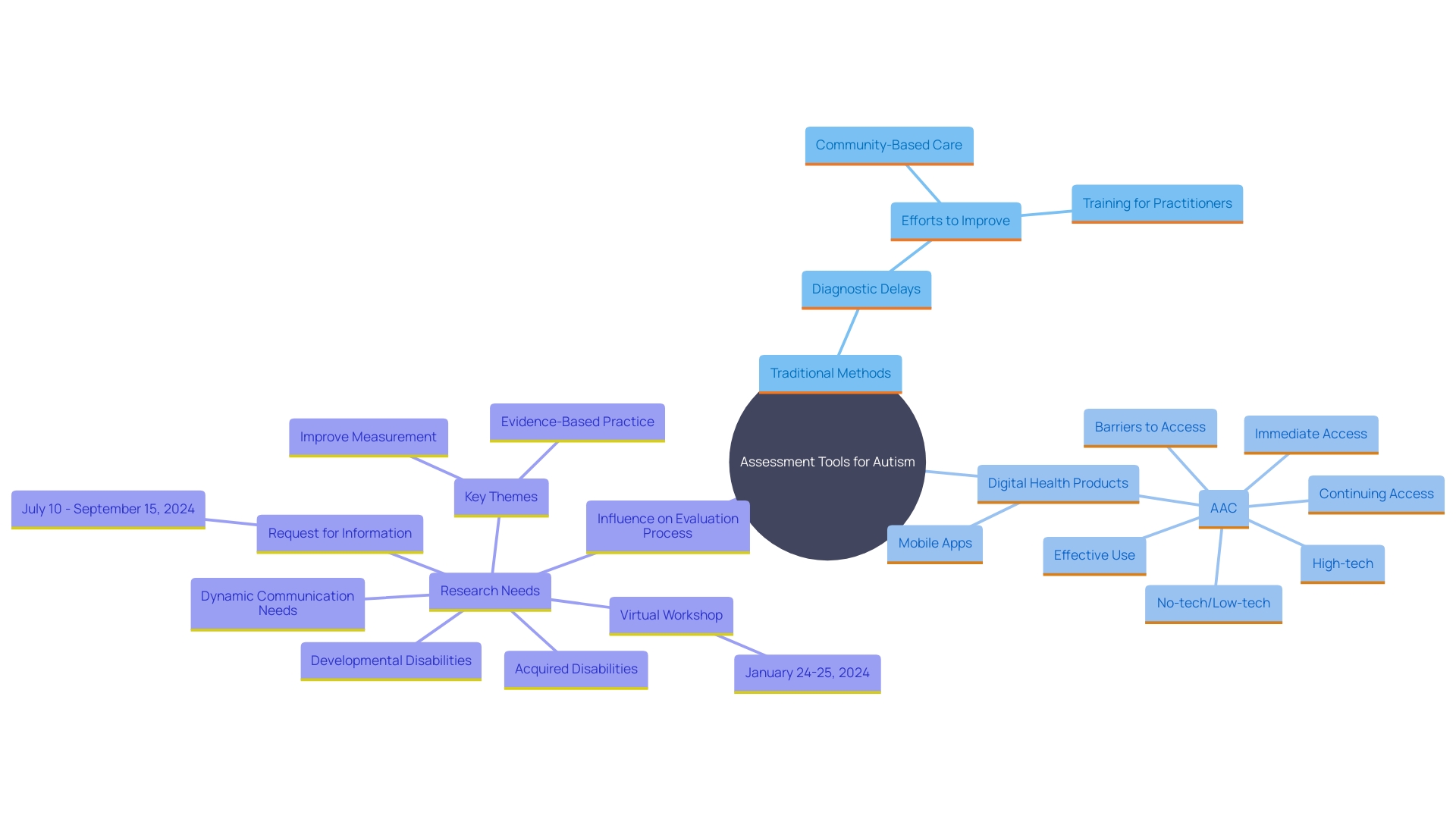
The Importance of Professional Diagnosis
While quizzes like the AQ can provide insight, a professional diagnosis is essential for accurate understanding and support. Qualified professionals can evaluate the results within a broader assessment, ensuring that necessary interventions and resources are identified. Encouraging parents to seek professional guidance can empower them in advocating for their offspring's needs. The Interagency Autism Coordinating Committee (IACC), composed of various federal agencies and stakeholders, emphasizes the importance of coordinated efforts in autism research and services. As Dr. David (Dan) R. Offord, a renowned youth psychiatrist, once stated, “Growing up in Canada is like a race. I do not mind if my kids are in a race as long as the race is fair. Ensuring fair access to resources and support is crucial for the well-being and equitable participation of young people with disabilities. Engaging in professional evaluations aids in recognizing unmet needs and leveraging the strengths of autistic children, fostering their healthy development and overall well-being.
Conclusion
Understanding the Autism Spectrum Quotient (AQ) is crucial for parents and caregivers navigating the complexities of autism. This diagnostic tool provides insights into various traits associated with autism, emphasizing the importance of accurate and early diagnosis. By recognizing the components of the AQ, including social interaction and communication skills, caregivers can better interpret results and identify areas where additional support is needed.
The structured methodology of the AQ, alongside its tailored versions for different age groups, underscores the necessity of utilizing appropriate assessments. However, it is vital to remember that the AQ should not be used in isolation. A comprehensive evaluation involving professional assessments ensures a holistic understanding of an individual’s needs, facilitating effective intervention strategies.
Professional guidance remains paramount in interpreting AQ scores and determining subsequent actions. Engaging qualified professionals helps bridge gaps in understanding and ensures that the unique characteristics of each child are considered. The collaborative efforts among various stakeholders in autism research and services further enhance the support available to families.
In conclusion, the journey toward understanding and supporting children on the autism spectrum requires informed decisions and proactive engagement with diagnostic tools like the AQ. By fostering a deeper understanding of autism and advocating for timely interventions, parents and caregivers can significantly enhance the developmental outcomes for their children, promoting an inclusive and supportive environment.




